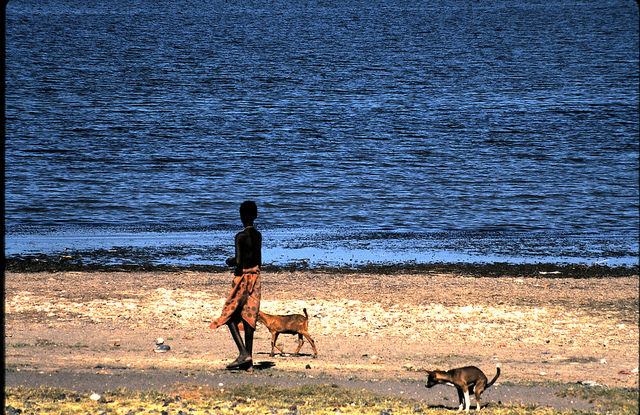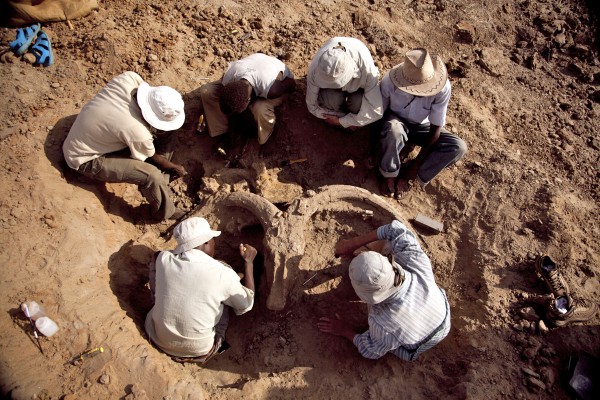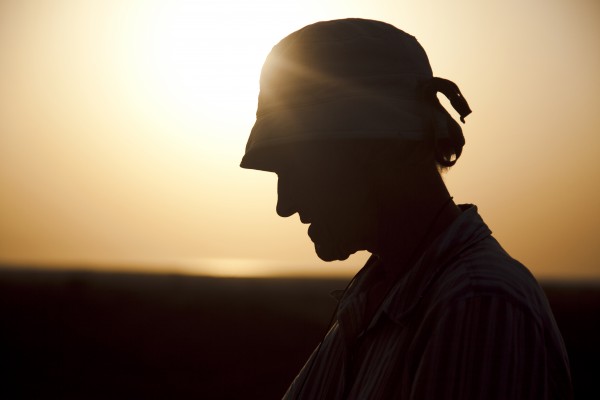The Leakey family is like the Kennedys, but for paleoanthropology instead of politics. Think about any
hominin fossil or artifact you can name. Chances are, there was a Leakey involved in its discovery. Louis Leakey was one of the first scientists to champion the idea that humans had their origins in Africa. For three generations now, his family has carried out active paleo excavations in eastern Africa, especially the countries of Tanzania and Kenya.
The first generation—Louis Leakey and his wife Mary—were most associated with Tanzania's Oldupai Gorge. But their son Richard, his wife Meave, and their daughter Louise have all spent their careers focused on Lake Turkana, on the border between Kenya and Ethiopia. The site is the world's largest, permanent desert lake. Undisturbed by modern development, in a spot where millions of years of flowing water have washed deposits and fossils down from the rift valley—Lake Turkana is an excellent place to search for human ancestors and our ancient relatives.
On Wednesday, PBS will air an hour-long documentary on the Leakeys' work at Lake Turkana. Part biography of Richard Leakey and part exploration of human history—
Bones of Turkana will air May 16th at 9:00 pm central and again on May 21st at the same time. Yesterday, I got the opportunity to speak with Richard and Meave Leakey. We talked about human evolution, the scientific promise of Lake Turkana, the process of paleo fieldwork, and the lasting impression of the Leakey legacy.
First, a bit of context. Although he's the more famous of the two, Richard Leakey hasn't really been doing paleoanthropology for 20 years. Instead, he's worked in wildlife conservation—especially with elephants. He's also participated in Kenyan politics, including helping to found a new political party there in the late 1990s. Currently, he's focused on fundraising for the
Turkana Basin Institute, an organization aimed at providing logistical and financial support to researchers from many disciplines working in remote parts of Kenya. Previously the site of a base camp for Leakey work at Lake Turkana, the Turkana Basin Institute will soon be home to a permanent
building. "Now it’s a place where scientists can do research without having to live in tents and eat sand," Richard Leakey told me. "And we can give local nomadic people permanent jobs in curatorial duties with collections on site. Traditionally, people found fossils and took them away. We’re turning that around now, so that the local economy gains as well."

Maggie Koerth-Baker: Richard, what drew you to Lake Turkana in the first place?
Richard Leakey: I had been working in southern Ethiopia representing my father in 1968 and 1967 [He would have been around 24 at the time—MKB]. I didn’t really enjoy it, I was very much the junior person on the expedition. But I had dropped out of high school and didn’t have any credentials except my experience. I knew that to go any further in my career I'd either have to go to university or I’d need a to find a really good site and build team around me. So that’s what I chose to do. I happened to notice that Lake Turkana looked very promising geologically—there were formations suggesting that the lake had fluctuated in depth and size over millions of years. There was sediment from river systems that often contains fossils. You had exposure through modern erosion, and there was very little vegetation. In 1968, I went in to check it out more closely. Immediately, we started finding fossils and lots of them.
What’s important about Lake Turkana is that it’s been there, growing and shrinking, for four million years, if not longer. There's this continuous record that exists in other places, but perhaps not as broad and rich. The work that’s been done so far suggests that other places aren’t as extensive. That’s what makes Turkana different from other sites we know of at the moment. But that's not to say that the other sites don't matter. It’s the combination of work done in South Africa, Tanzania, work being done in Ethiopia. It all adds up to a comprehensive picture. We’ve accumulated a huge amount of data at Lake Turkana but it would be less important than it is without that bigger continental sample.
MKB: Meave, you married into this family that had already been doing paleontology work for years. How has joining the Leakeys affected your work over the decades? Did the family business alter the course of your research?
Meave Leakey: It did entirely. I was doing marine zoology in university. I can’t think of anything further removed from paleontology. But my initial contact with Richard’s father led to me getting a job in his primate research center. I ended up doing my Ph.D. on modern monkey skeletons, and I got so interested in that that I left marine sciences behind entirely.
Then I met Richard and he invited me up to Turkana to look at fossil monkeys. It was entirely Richard who got me started in the field work. As soon as I got there I really loved it. In that sense, the Leakeys directed the opportunities that led to what I do today. Being married to Richard led to my interest in fossil human ancestors. I was mostly interested in monkeys for years, that was what I studied. But in 1989 he went into wildlife conservation and that left me in the position of leading the fieldwork.
MKB: From your perspective, is it reasonable to focus so much our research energy on this one place, on Lake Turkana? I’m curious about the trade offs we make here between looking for fossils in a location that we already know so much about, because it’s been so well studied versus looking for fossils in places that haven’t been explored yet, where we might find something we’re missing at Turkana.
ML: I think the thing to understand about Turkana is that it’s very huge. We work with many colleagues in different disciplines, looking at lots of different angles and that’s what makes it exciting. You have geologists interpreting the lake’s history. Geochemists looking at dominant vegetation. The main overall focus is how and why our ancestors evolved and how they became us. The big questions relate to that. But climate is important. Environments are important. Extinctions are important. There’s many different questions and aspects and approaches to the one main focus.
We have an enormous backlog of work that’s been done there, 45 years worth or so. We have a huge amount of information about the lake basin. On the other hand, when someone comes up with a new site in Africa, you have no idea what you’ll find and that gives you a better idea of what you’re seeing in Turkana. We tend to think that Turkana gives you the right picture of our past, but it doesn’t. It’s just a little pinhole view. The rest of Africa might have something entirely different going on. Personally, I wouldn’t want to work anywhere else because my expertise is in that specific lake basin. But I think we should be finding as many sites as possible all over the world. That's how you get the big picture.
MKB: You both have had a lot of experience finding new fossil specimens, so I wanted to ask you about a part of paleo work that's often very difficult for laypeople to understand. How do you go about distinguishing where a new specimen fits in the human family tree, whether it's part of an already identified species, or something new? That can seem like a really subjective thing from the outside.
RL: I would say that people have generally gone about explaining this backwards. The very earliest things that are our ancestors, quite frankly they don’t look like us at all. I think it’s much more important to look from the present and go back. When you find 10,000-year-old old skeletons they look just like us. In fact, modern looking goes back to 200,000 years. Then, I think we tend to go further and start really seeing the differences. At 1.5 million years ago, it’s not like us at all. If we presented it this other way, from present back, I think we’d have more understanding from the public.
ML: It really is a lot of work to establish that you’ve got something different and that it’s not just variation within the species. The main comparative example you use is to take the gorilla, which has a huge size and shape difference between males and females. Gorillas have the most variation within a species of all modern primates. You look at that very extreme variation and you assume you're unlikely get a much higher degree of variation within a species than that. Then you compare all the points on your new specimen with known species and you see if it fits within that range of variation. If it exceeds the gorilla level of variation you’ve got a pretty good case for a new species.
And the truth, with this method, is that you're likely missing species. If you were to take a series of modern monkey skulls and break them apart the way we find them in the fossil record, there’s no way you’d call them different species. But you know in the modern situation that they are different. If anything, we’re conservative on this.
MKB: One of the things that really stood out to me from your new documentary was the way the narrative associated tool making and tool use with an important step in non-humans becoming humans. How does that idea work with all that we now know about the many, many other animals who use tools. It's not even just primates, right?
RL: It’s quite subtle. We know birds use tools and chimps and insects and lots of mammals. But to take a block of very hard stone and to take another stone and fashion an object from it, that's something different. You have to "see within" the stone to know what you’re fashioning before you fashion it. You have to project an idea. That's a step that no other tool maker uses. It’s an almost soft science definition but I can see a fundamental difference.
ML: I'd agree. Kanzi is a chimp that humans tried to teach to make stone tools. But his hands were simply the wrong shape. They don’t have the precision of grip we have and they have less flexible grip. It wouldn’t have been possible for Kanzi to make a tool as professionally as our ancestors did. We haven’t found tools older than 2.5 million years old. I’m sure that’s not the last word on this. There might be ones found that are older, but as you go back, the hand then becomes less and less flexible. The limiting factor would be the morphology of the hand. It's more that and less the morphology of the brain, in my opinion. This aspect of being human very much depends on hand flexibility.
MKB: Meave, your team found the skull of Kenyanthropus platyops—a 3 million year old hominin—at Lake Turkana in 1999. (Other scientists argue that this skull doesn't represent a new genus, but is rather a species ofAustralopithecus.) Why do we find so many skulls and skull fragments? Shouldn't there be equal quantities of other ancient hominin bones?
ML: We do find more skulls than you’d expect. I think it has to do with the size of the brain, or rather the size of the actual skull. Other remains can get chewed up by carnivores. They aren’t as complete. But the skulls we do find in greater number than you might expect. Maybe it's becuase carnivores couldn’t get their mouths around the skull and cruch it up, because the brain was so big. I'm speculating, but when you get back to something like
Lucy, you don’t find more skulls than other bones, maybe because the brain was smaller and the carnivores were bigger. We do find other peices but they’re usually pretty fragmentary. And we're missing lower jaws a lot, because those can be chewed up. Monkeys are another good example. There are fewer fossil monkey skulls as complete as hominid skulls, and that's even though we find far more monkey specimens.
MKB: Richard, you grew up in the field, doing fieldwork alongside your parents. You and Meave both raised your daughter in the field. What is that experience like? Why do you think that paleontology has become this very family-oriented job for the Leakeys in a way that other industries just aren't?
RL: If you have an opportunity to be involved in fieldwork it's hugely exciting and rewarding. You’re out in the open in nature, unbothered by emails and telephones. And once you enjoy fieldwork, paleontology is one of the professions where you can devote a lot of time to that. I think that's what draws you back into it as an adult. as A result of my childhood is that I always had a natural curiosity about origins, extinction, and evolution. It’s a natural part of my life. It’s not the only thing that interests me, obviously, but fully understanding why we are what we are—I think it adds to the whole human experience.
ML: You also have to understand that we're only three months of the year in the field and those months tend to fall within school holidays. Our children were in the field with us the entire time, from the time they were babies. They were in the camp or in the base. We'd take them out now and again and they'd get very excited about finding things. When they were older, they were able to start helping in camp, picking out bone fragments. The result of all of that exposure is that they say they definitely won’t get into the subject as adults. Of course, Louise said exactly that, but now she’s fully involved. Our other daughter said no and kept her word.
IMAGES:
Image 1: The Leakey family excavating a pelorovis skull. Our human ancestors once feasted on these ancient bovids (akin to cows). Courtesy National Geographic Television.
Image 2: Kenya 1987 Lake Turkana woman and dogs, a Creative Commons Attribution Share-Alike (2.0) image from wfeiden's photostream.
Image 3: Meave Leakey. Courtesy National Geographic Television.
SHARE THIS POST 








